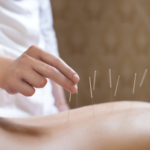An astounding 20% of adults in the United States deal with chronic pain in their everyday lives. This makes it one of the most common disabilities in the country, as chronic pain often affects mobility. If you’re among the one in five people with chronic pain, you might be looking for a way to alleviate pain, but are wary of opioid pain medications, as the percentage of adults addicted to these substances is also shockingly high.
Don’t worry, there are a number of effective pain relief methods that require no pills or invasive treatments. To learn about 7 of these methods, just keep reading.
Table of Contents
1. Acupuncture
The first, and one of the most effective of all alternative pain relief methods, is acupuncture. During this form of therapy, a trained acupuncturist will use tiny needles to stimulate specific points on or under the skin.
These needles put the nervous system into action, causing the brain to release feel-good hormones, reduce inflammation, and promote nerve regeneration.
Now, many people shy away from the idea of acupuncture due to a fear of needles. This is totally understandable. However, the needles used in acupuncture are so small that you’ll feel a small pinch at the very most, but most people don’t feel anything at all.
2. Chiropractic Care
When you think of chiropractic care, the first thing that likely comes to mind is back pain relief. And while this is true, chiropractors can work wonders with back pain, they’re also experts at treating a variety of pains and conditions.
Because they specialize in neuromusculoskeletal conditions, they can treat pain in the neck, back, and joints, as well as the muscles. They employ a number of treatment methods to do this, but the most common is spinal manipulation. In this treatment, a chiropractor will manually adjust your spine, restoring joint mobility and promoting tissue healing.
3. Massage Therapy
Alongside chiropractic care, your chiropractor might recommend massage therapy to boost the treatment of your chronic pain. You can also seek out massage therapy on its own as a method of treating pain. Massages are only good for a Sunday afternoon relaxation session!
A massage therapist is trained to stretch and knead your muscles and other soft tissues to relax your body and reduce inflammation. In addition, the increase in blood flow to the painful areas of your body through massage will promote healing.
4. Meditation
The mind and the body are closely connected; so close, in fact, that the way you think can affect the way you feel. If you’re focused on your pain, your body’s stress response will kick in, increasing the amount of cortisol and other stress hormones in your bloodstream. This will cause inflammation and heighten your level of pain, making pain management that much harder.
This is where meditation and other mind-body practices come in. By calming your mind, you’ll calm your body, in turn, decreasing your anxiety and pain perception.
Meditation doesn’t have to mean sitting in silence for hours on end. You can journal, start a gratitude list, or practice guided imagery. This is the practice of closing your eyes and imagining your pain decreasing.
It might sound too good to be true, but guided imagery has been proven to be an effective treatment for everything from chronic pain to depression.
5. Exercise
When you’re in pain, your first instinct might be to sit or lie still, but this is a major mistake. One of the best therapies for pain is movement! So when you’re experiencing a bout of pain, consider taking a walk around your neighborhood instead of lying on the couch.
We should all aim for a minimum of 150 minutes of physical activity per week anyway. If you reach or exceed this goal, you’ll not only be decreasing your pain levels but improving your overall health as well. You’ll have more energy and feel better in both your mind and body.
6. Herbal Remedies
Never underestimate the healing powers of the Earth. Herbal medicines have been used in the treatment of pain and other ailments for centuries, long before pharmacological options had ever been invented.
There are a variety of herbs that contain healing properties, some of which have been shown to have the same effect on the body as NSAIDs such as ibuprofen. A few of the best options are capsaicin, found in chili peppers, ginger, and turmeric.
You should also consider looking for kratom gummies and other vitamins to improve your health while contributing to your pain management regimen.
7. Aromatherapy
Speaking of herbal medicines, if you’d rather inhale your herbs than ingest them, aromatherapy is the choice for you. Like guided imagery therapy, aromatherapy might sound a little too good to be true. All you have to do is smell something to get the effects?
Well, yes. Aromatherapy has been a common treatment for all sorts of ailments for centuries, including pain. Different oils have different effects on the body, but those most effective for pain management include peppermint, lavender, and chamomile oil.
The scent of these oils stimulates the limbic system, which sends signals to your body that ease chronic pain and reduce anxiety.
8. Use a sauna
Sweating boosts the flow of blood circulation to your body and muscles, reducing the time it takes to heal from injuries and muscle strains. Studies have even shown that using an Infrared Sauna has helped people who suffer from fibromyalgia in combination with underwater exercise.
Alleviate Pain and Become a Better You With These Pain Relief Methods
No matter how hard we try, it’s impossible to be our best selves when dealing with chronic pain. And it isn’t something you should expect from yourself.
By using these alternative methods to alleviate pain, however, you’ll find that you feel less pain in your day-to-day life. You might even discover that your pain has become a thing of the past.
Looking for more tips for managing your chronic pain through natural means? Be sure to check out our blog!











